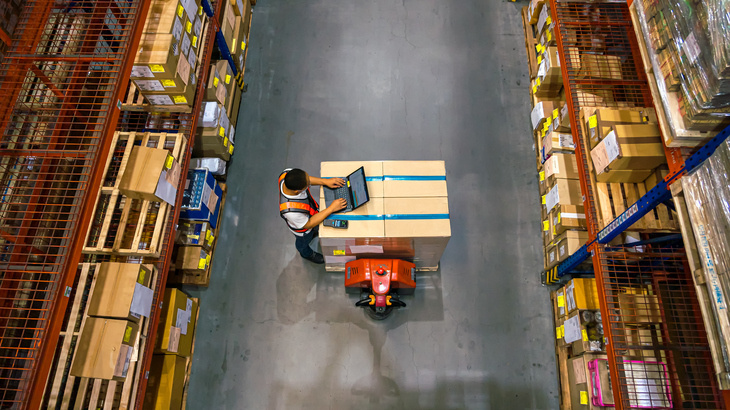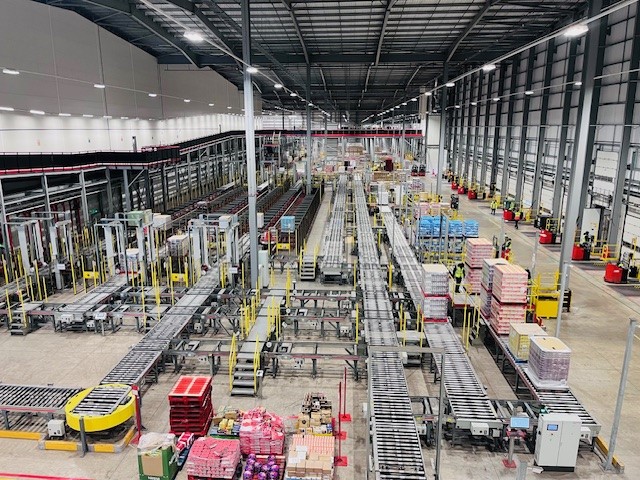How automation is transforming logistics
Ever wondered what goes on inside a giant high-tech logistics site? We share our insights from a visit to a next-generation site, revealing how technology is meeting the changing needs of today's consumers.

In recent years technology has transformed the logistics industry. From unmanned aerial vehicles to item-picking robots, innovative technologies are revolutionising how goods are stored and dispatched.
Earlier this year, we visited a GXO Logistics*-run site in the UK to see the latest logistics technology for ourselves, shining a light on this hidden world. Arriving at the warehouse, the first thing we noticed was that the carpark was virtually empty.
Despite occupying 638,000 square feet – making it comfortably bigger than the grounds of Windsor Castle – the site runs with only around 200 staff, split across three shifts providing 24/7 coverage.
End-to-end digitisation
The term ‘digital warehouse’ made sense to us as soon as we stepped into the facility: automation begins the moment goods enter the warehouse and continues through to pallets being loaded onto delivery trucks.
Something that surprised us was how quiet and neat the warehouse was, as we expected a lot of noise from conveyor belts and vehicle reversing sirens. However, as Neil Shelton, Chief Strategy Officer at GXO Logistics, quite rightly said, “A chaotic solution is a site which does not operate efficiently.”
The warehouse handles all size of orders, from small Sainsbury's* Local deliveries comprising 10 different products on a smaller pallet to the biggest Tesco* supermarket orders, with single products displayed over 20 pallets.
The site is fully automated, with a monorail and conveyers transporting goods in different areas for picking, sorting, pallet and goods gathering, wrapping, goods and delivery information labelling. Different sensors and optical technologies are leveraged to check whether the goods are safely placed on pallets throughout the site.
Inside the warehouse: the technologies in use
The packing station was particularly interesting, as we could witness collaboration between employees and technologies, including ‘cobots’ – robots that are designed to operate collaboratively with humans. Robot packing arms can pack twice as fast as their human counterparts, but struggle with certain smaller or more delicate items. This is where humans step in to ensure delicate goods aren’t damaged.

The labelling station was also fascinating. In a single 12-hour day a worker can label 80,000 cases. This incredible rate of productivity is possible thanks to automated trays and artificial intelligence camera systems helping optimise the workflow.
Labelling outbound goods means the system knows exactly how many goods, and which particular goods, are headed to which location.
The themes behind the technology
Our expert partner in robotics and automation Richard Lightbound was with us on the day of our visit, and he shared some thoughts after the trip. Below is a summary of his key points.
The world is increasingly integrated and demanding, and subsequently relies on a complex, almost magical, movement of goods globally. Resilience in systems is only as good as the weakest link.
Advancement in supply chain and logistics technologies spans many areas, such as automation and robotics in and out of warehouses, at ports, multi-modal transportation, planning and beyond.
Any disruption across any of these areas (from a price, availability or time perspective) can cause significant disruption and inflation, as seen by events such as COVID-19, the Suez Canal disruption, the shortage of chips, etc.
Global resilience depends on making fail-safe and dependable systems. A key theme to think through that applies beyond supply chains and logistics is the concept of maximum efficiency. This is the idea that assets and consumption can be optimised both through superior technology and policy changes.
The above is an extract from our full article on the site visit.
* For illustrative purposes only. Reference to a particular security is on a historic basis and does not mean that the security is currently held or will be held within an LGIM portfolio. The above information does not constitute a recommendation to buy or sell any security.
Rischi principali
Il valore di un investimento e l'eventuale reddito che ne deriva non sono garantiti e possono scendere come salire; potreste non recuperare l'importo originariamente investito. La performance passata non è garanzia di risultati futuri
Sebbene LGIM abbia integrato considerazioni di carattere ambientale, sociale e di governance (ESG) nel proprio processo decisionale di investimento e nelle pratiche di stewardship, ciò non garantisce il raggiungimento degli obiettivi di investimento responsabile nei fondi che non includono obiettivi ESG specifici tra i propri obiettivi.
I rischi associati a ciascun fondo o strategia di investimento devono essere letti e compresi prima di prendere qualsiasi decisione di investimento. Ulteriori informazioni sui rischi dell'investimento in questo fondo sono disponibili nel prospetto informativo all'indirizzo http://www.lgim.com/fundcentre.





